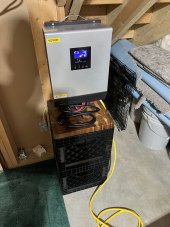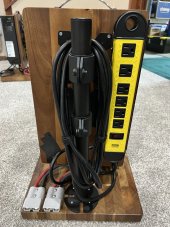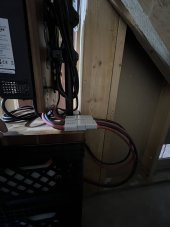jackal830
New Member
Saw how small the LiTime Minis were and thought I could make a modular milk crate system. Turns out they are just the right size to be able to stuff them in a milk crate and still have room to grab the handles to lug them around.
The crates are each 42.5 pounds and the inverter section is 29 pounds.
System:

Milk Crates:

System Rear (wood cutting board on top of a wooden serving plate, lol):

Rear Power Connections

120A Circuit Breaker at each milk crate:

Inverter Mount Bottom (spacers to make sure lid will sit center on top of crate):

Carrying the inverter via handle (replaced 3/4 inch screws with 1.5 inch screws to better hold the handle)

I tested it out this weekend hooking up to my gas furnace. It's been 36 hours and it's still powering it (although almost dead). It's been in the 30's here, I suspect in blistering cold it wouldn't last a day, but still not bad.
The inverter wasn't made for LIFEPO4 (probably a reason why it was selling for $230). You can manually adjust charging and discharging voltage behavior to not damage your batteries, but the battery charge meter is totally oblivious as to how LIFEPO4 batteries work. Looking at actual voltage is the only way to tell how much charge is left.

I actually bought 2 inverters because they were so cheap. They are rated for 2400W, but I have 15A fuse on power strip.
Cost for one system (including wiring, lugs, etc) should come out to be around $1500 or so. I spent closer to $2000 with the extra inverter and everything required so I could run two simultaneously (each with one crate). I don't have any solar hooked up to it. I have solar on my house, but it's grid tied enphase, so charging would be tricky during a grid-down scenario.
Batteries are in series within the crate and parallel out of the crates to the inverter. Can hook one or two crates up. The two andersson connectors go up to 1AWG lugs (two 4AWG cables) for the parallel connection.
The crates are each 42.5 pounds and the inverter section is 29 pounds.
System:

Milk Crates:

System Rear (wood cutting board on top of a wooden serving plate, lol):

Rear Power Connections

120A Circuit Breaker at each milk crate:

Inverter Mount Bottom (spacers to make sure lid will sit center on top of crate):

Carrying the inverter via handle (replaced 3/4 inch screws with 1.5 inch screws to better hold the handle)

I tested it out this weekend hooking up to my gas furnace. It's been 36 hours and it's still powering it (although almost dead). It's been in the 30's here, I suspect in blistering cold it wouldn't last a day, but still not bad.
The inverter wasn't made for LIFEPO4 (probably a reason why it was selling for $230). You can manually adjust charging and discharging voltage behavior to not damage your batteries, but the battery charge meter is totally oblivious as to how LIFEPO4 batteries work. Looking at actual voltage is the only way to tell how much charge is left.

I actually bought 2 inverters because they were so cheap. They are rated for 2400W, but I have 15A fuse on power strip.
Cost for one system (including wiring, lugs, etc) should come out to be around $1500 or so. I spent closer to $2000 with the extra inverter and everything required so I could run two simultaneously (each with one crate). I don't have any solar hooked up to it. I have solar on my house, but it's grid tied enphase, so charging would be tricky during a grid-down scenario.
Batteries are in series within the crate and parallel out of the crates to the inverter. Can hook one or two crates up. The two andersson connectors go up to 1AWG lugs (two 4AWG cables) for the parallel connection.


